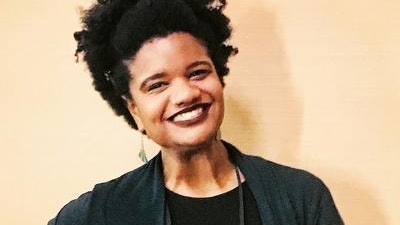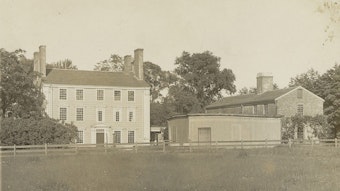In Dark Chapter of Harvard’s History, Family Subplots

Mary McNeil (Mashpee Wampanoag) is a PhD candidate in Harvard’s American Studies program and a research assistant for the African American Trail Project at Tufts University.
With support from the Harvard and the Legacy of Slavery initiative, which is anchored at the Radcliffe Institute, McNeil is examining the University’s connections to the slave trade by tracing its financial links to the enslavement of American Indians.
Your dissertation examines Black, Native, and Afro-Native relationships to land in Boston during the Red Power and Black Power movements. What sparked your interest in that topic?
My research is informed by the present moment. I’ve lived in Boston for 10 years; I’m seeing how quickly the city has spatially and demographically changed. Boston is one of many cities that has a profound housing crisis. Also, my family and I are enrolled members of the Mashpee Wampanoag Tribe. Since Trump has been elected, we’ve suffered a pretty sustained attack on our homelands. So, I’m standing in this moment of what I regard as profound displacement and the undermining of tribal sovereignty in Massachusetts. It made me think about the blueprints that ancestors have proffered to respond to moments of displacement.
Your Radcliffe project stretches further back in history, to the colonial period. But it also examines relationships to land. How are the dissertation and your Radcliffe work connected?
Part of my interest for both projects is to map the connections between the African Disapora and Native communities. That’s very much a part of my family story. That’s how I came to exist in the world.
Within that, one of my goals is to map overlapping carceral geographies. For example, Deer Island was a space of internment during King Philip’s War. Native American communities were relocated to Deer Island in the winter of 1675. It ultimately becomes this site of immense trauma and violence. What is less talked about is that the island is consistently the site of various penal institutions throughout the 19th century—until the early 1990s actually. This was striking to me.
In terms of my Radcliffe project, I’m interested in tracing and trying to ascertain Deer Island’s connection to the Native American slave trade. This slave trade was heavily operating out of the Northeast, especially in Massachusetts, in the early colonial period. Oftentimes Native folks—who were effectively prisoners of war—were held in detention in Boston and then sold into slavery into the West Indies as well as Bermuda. I’m trying to understand who were the primary actors in that slave trade, and their connections to Harvard and to governing structures that allowed Massachusetts to grow and become what it is today.
You’re mainly focusing on one family and their connection to Harvard. Can you describe that family and what you’ve learned so far?
John Hull was a Boston merchant and a pretty prosperous man. He sold Native folks down the coast to the West Indies. Preliminary research finds that he has multiple Harvard connections. He gave a grant of 100 pounds, Massachusetts currency, to the college in 1681 to sustain it. His daughter and son-in-law, Hannah and Samuel Sewall, also gift a land grant of about 500 acres to the college in 1696. That land was in Narragansett Country, a Native nation in Rhode Island. This particular family made significant contributions to the college in its early years—but they were implicated in the Native American slave trade. There are also larger trends to examine of dispossession of Native land during this period and how instrumental that was to the success of the college in its early years.
What’s the most interesting item you’ve uncovered in your research?
Massachusetts politicians and intellectuals from the 18th and 19th centuries are thought of as very progressive on social issues, but the archival record often complicates this image. For example, Samuel Sewall actually published one of the first antislavery texts in America, “The Selling of Joseph.” Here’s this figure who is widely known as an early antislavery activist, who makes a moral case against slavery, and yet, his father-in-law is involved in the slave trade, albeit the Native American slave trade. Trying to parse those contradictions is something that this project has really brought to bear for me. I don’t have a final conclusion yet. It’s very challenging to think about.
What is your desired outcome for this research?
There is so much that folks need to know to understand the history of where they are. Harvard has an endowment that is probably the GDP of small countries. And yet, that wasn’t necessarily a foregone conclusion. The College really struggled in the early 17th century. It’s really important for us to reckon with the fact that a powerful institution such as Harvard was dependent on donations from folks who perpetuated violence. I hope that also opens up questions about responsibility to local Black and Native communities. I see my research as laying a foundation for these longer questions about violence and redress.
Interview was edited for clarity and length.








